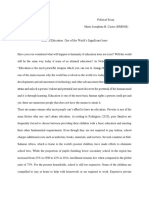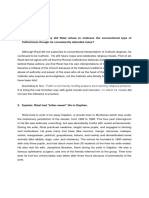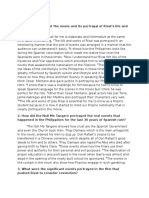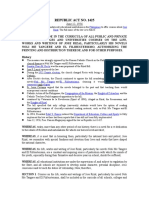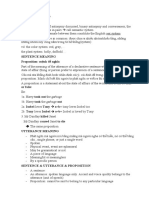M2L1: Tracing Rizal's Historical Roots - While Task 1
M2L1: Tracing Rizal's Historical Roots - While Task 1
Uploaded by
24 PAULINO ALDRIN MUJARCopyright:
Available Formats
M2L1: Tracing Rizal's Historical Roots - While Task 1
M2L1: Tracing Rizal's Historical Roots - While Task 1
Uploaded by
24 PAULINO ALDRIN MUJAROriginal Description:
Original Title
Copyright
Available Formats
Share this document
Did you find this document useful?
Is this content inappropriate?
Copyright:
Available Formats
M2L1: Tracing Rizal's Historical Roots - While Task 1
M2L1: Tracing Rizal's Historical Roots - While Task 1
Uploaded by
24 PAULINO ALDRIN MUJARCopyright:
Available Formats
M2L1: Tracing Rizal’s Historical Roots | While task 1
1. What were the historical conditions that led to the emergence of Chinese mestizo as an important
element of Philippine society?
The recorded history in the Philippines would be imperfect if the Chinese “mestizos” are not included as
a basis for understanding today’s society. They’ve played an important role during the 19th century
Philippine society. Most of the few Chinese in the Philippines that time had gathered in Manila in which
they provided trade goods and services that Spaniards can’t do. As immigrants’ population grew, many
Chinese took this liberty to their advantage, so they spread across different places within the country.
They come to Luzon and to some of the southern islands. From there on, they became more powerful
when it comes to commerce. Thus, they became significant in the Philippine economy as they go way up
their places there. They were considered by the Spaniards as “sangley” or pure-blooded Chinese people.
Also, some Chinese immigrants also married native Filipino people. Later, the intermarriage of Filipino
natives and the Chinese produced a new class called the Mestizo de Sangley. These Chinese Mestizo or
Mestizo de Sangley become one of the hundred ethnic groups of the Philippines. The rise of the
mestizos shows the existence of social change during the Spanish period. By the end of the Spanish era,
the Chinese Filipinos comprised the middle class of Philippine society. People belonging to this class had
greater privilege when it comes to education and were thus instrumental in the Philippines’ fight for
freedom. This new group gave birth to the educated illustrados like Jose Rizal and Marcelo H. del Pilar
who started the Philippine Revolution. Because of what happened, Filipino nationality is formed. Today,
Chinese mestizo’s significance in the Philippines continues. Many “Chinoys” occupied important
positions in the government such as Vice President Sergio Osmena, Presidents Jose P. Laurel Elpidio
Quirino and Ramon Magsaysay.
2. What were the implications of their ascendance?
China and the Philippines have shared a long enduring relationship before spain conquered the
Philippines. The Philippines’ relationship with China is by far the longest the Philippines has ever had
with any country outside Southeast Asia. Just look at the over 400-year-old Binondo, the oldest
Chinatown in the world, being situated in the Philippines. Throughout their long withstanding historical
ties, they have shared inter-ethnic relations, territorial disputes, maritime conflicts, diplomacy and
foreign policy, trade and economic partnerships. The Chinese’s skills in commerce and trading also
influenced the FIlipino culture. One major influence that the Chinese contributed within the culture was
culinary arts. In addition, the Chinese way of family structure also heavily influenced the traditional
Filipino family structure. The traditional Filipino structure is very rigid, authoritarian, and uses Chinese-
based nomenclature.
You might also like
- Deep Vein Thrombosis (NCP)Document4 pagesDeep Vein Thrombosis (NCP)24 PAULINO ALDRIN MUJAR0% (1)
- Dugin, Alexander - Martin Heidegger. The Philosophy of Another BeginningDocument475 pagesDugin, Alexander - Martin Heidegger. The Philosophy of Another Beginningpatriamilitante100% (3)
- Case Scenario: Prostate CancerDocument5 pagesCase Scenario: Prostate Cancer24 PAULINO ALDRIN MUJARNo ratings yet
- Call of Cthulhu - Red Eye of AzathothDocument108 pagesCall of Cthulhu - Red Eye of AzathothAlexander Collings100% (8)
- Rizal (M2L1)Document3 pagesRizal (M2L1)Louise BattadNo ratings yet
- Presented By: Pallavi Gogoi Reg. No. PG20102228Document15 pagesPresented By: Pallavi Gogoi Reg. No. PG20102228pallavi_gogoi_pgp12No ratings yet
- Allergic Rhinitis (NCP)Document3 pagesAllergic Rhinitis (NCP)24 PAULINO ALDRIN MUJAR33% (3)
- Modern Tragedy by Raymond WilliamsDocument20 pagesModern Tragedy by Raymond WilliamsUme UmaraNo ratings yet
- Tracing Rizal's - Historical - Roots - While TaskDocument2 pagesTracing Rizal's - Historical - Roots - While TaskIrene M. MacapagongNo ratings yet
- 3 Important Things I Realized From The Reading (Elaborate)Document4 pages3 Important Things I Realized From The Reading (Elaborate)chrysandra marinNo ratings yet
- Chapter 10Document22 pagesChapter 10BARCELON, CHRISTOPHER JAMESNo ratings yet
- Jose Rizal (1998) ReviewDocument2 pagesJose Rizal (1998) ReviewEnrique Manuel ArantonNo ratings yet
- BONETE - Module 2 Learning Tasks PDFDocument3 pagesBONETE - Module 2 Learning Tasks PDFKRISTINE MAE BONETENo ratings yet
- DANICA DE LEON - Task Sheet #02 (Philippine Constitution)Document6 pagesDANICA DE LEON - Task Sheet #02 (Philippine Constitution)DANICA DE LEONNo ratings yet
- Differences of Noli Me Tangere and El FilibusterisDocument1 pageDifferences of Noli Me Tangere and El FilibusterisDummy GoogleNo ratings yet
- CWTS - Livelihood Project PlanDocument2 pagesCWTS - Livelihood Project PlanKaye BaguilodNo ratings yet
- Reflection Paperon On RizalDocument2 pagesReflection Paperon On RizalXeuweenNo ratings yet
- Name - Kleah Comillo - BSN1 (Chapter5)Document2 pagesName - Kleah Comillo - BSN1 (Chapter5)Holyver TabarnillaNo ratings yet
- M2 Post Task - Political Essay (CASTRO)Document3 pagesM2 Post Task - Political Essay (CASTRO)MARIE JOSEPHINE CASTRONo ratings yet
- What Is The Message of The Poem My Last Farewell?Document3 pagesWhat Is The Message of The Poem My Last Farewell?Nathan KitaneNo ratings yet
- Medically Significant AlgaeDocument4 pagesMedically Significant AlgaeKaren SanrilleNo ratings yet
- Elec 121Document14 pagesElec 121MARITONI MEDALLANo ratings yet
- Source: Sonia S. Daquila. The Seeds of RevolutionDocument6 pagesSource: Sonia S. Daquila. The Seeds of RevolutionJulliena BakersNo ratings yet
- Change and Development Relation To Rizal's Life: EconomicDocument2 pagesChange and Development Relation To Rizal's Life: Economicfarhanah ImamNo ratings yet
- EVALUATIONDocument2 pagesEVALUATIONJose Miguel Lopez100% (2)
- Assignment #1Document3 pagesAssignment #1Mich ElbirNo ratings yet
- This Study Resource Was: Act 1425 Realistic? Why or Why Not?" Answer This Question From Your Own Perspective, AsDocument1 pageThis Study Resource Was: Act 1425 Realistic? Why or Why Not?" Answer This Question From Your Own Perspective, AsKalia SharNo ratings yet
- Noli and El FiliDocument6 pagesNoli and El Filialexandra garciaNo ratings yet
- Reaction Paper Super Typhoon YolandaDocument3 pagesReaction Paper Super Typhoon YolandaDPDA DPDONo ratings yet
- The Contemporary World: MODULE 3: Global MobilityDocument16 pagesThe Contemporary World: MODULE 3: Global MobilityJeric RepatacodoNo ratings yet
- Rizal's Religious ViewsDocument24 pagesRizal's Religious ViewsFrancisco PizarroNo ratings yet
- Lariosa - 3A - Exile, Trial, and DeathDocument2 pagesLariosa - 3A - Exile, Trial, and DeathAllan Gabriel LariosaNo ratings yet
- The Role of Chinese Mestizos in The PhilippinesDocument8 pagesThe Role of Chinese Mestizos in The PhilippinesEric Gasgas CeletariaNo ratings yet
- Chinese Mestizos and The Formation of Filipino NationalityDocument23 pagesChinese Mestizos and The Formation of Filipino NationalityraineydaysNo ratings yet
- The Indolence of The FilipinosDocument5 pagesThe Indolence of The FilipinosPaulo Benedicto VillarNo ratings yet
- Declaration of Martial LawDocument4 pagesDeclaration of Martial LawSantos CathyNo ratings yet
- Amazing Earth: How Do We Maintain Waste Management Underwater?Document2 pagesAmazing Earth: How Do We Maintain Waste Management Underwater?RYNA IZABELLE D. GAUTANENo ratings yet
- Elementary Students Being Taught of Sex EducationDocument3 pagesElementary Students Being Taught of Sex EducationAccel FiestadaNo ratings yet
- Lesson 12: The Novel: Noli Me TangereDocument4 pagesLesson 12: The Novel: Noli Me TangereErika ApitaNo ratings yet
- National Museum of AnthropologyDocument13 pagesNational Museum of AnthropologyEdward Pacatang BonitaNo ratings yet
- The Essence of Values in NSTP: NSTP Midterm Exam ReviewerDocument12 pagesThe Essence of Values in NSTP: NSTP Midterm Exam ReviewerMIKAYLA ELAINE P. DELA CRUZNo ratings yet
- Filipino Cultural Interview PaperDocument13 pagesFilipino Cultural Interview Paperapi-285132682100% (2)
- RH BillDocument1 pageRH BillReuel PadillonNo ratings yet
- Santos, Lean Andrew B. - Philippine Popular Culture (Prelim) - Assignment 1Document4 pagesSantos, Lean Andrew B. - Philippine Popular Culture (Prelim) - Assignment 1software appNo ratings yet
- Reaction Paper of Jose Rizal's LifeDocument1 pageReaction Paper of Jose Rizal's LifePrincess MiralynNo ratings yet
- Common Questions On Autonomy PDFDocument37 pagesCommon Questions On Autonomy PDFPipoy AmyNo ratings yet
- Question 3Document1 pageQuestion 3Niño Dwayne TuboNo ratings yet
- Chapt - 8Document2 pagesChapt - 8Glomelyn Rose Ortiz TañedoNo ratings yet
- Idilio en Una Azotea: (An Idyl On An Azotea) Salient PointsDocument3 pagesIdilio en Una Azotea: (An Idyl On An Azotea) Salient PointsOMEGANo ratings yet
- RIZAL: RevolutionDocument3 pagesRIZAL: RevolutionEmman Caballero MabalingNo ratings yet
- College of Liberal Arts: Western Mindanao State University Normal Road, Baliwasan, Zamboanga CityDocument5 pagesCollege of Liberal Arts: Western Mindanao State University Normal Road, Baliwasan, Zamboanga CityAllyssa Mae De LeonNo ratings yet
- SDG Project ProposalsDocument5 pagesSDG Project ProposalsAnthony OrataNo ratings yet
- Morga's & Rizal's ViewDocument1 pageMorga's & Rizal's ViewDJ Lorenne R. BarnedoNo ratings yet
- University of Nueva Caceres-Bataan: 19 Century Philippines As Rizal's ContextDocument23 pagesUniversity of Nueva Caceres-Bataan: 19 Century Philippines As Rizal's ContextAiron BendañaNo ratings yet
- Jose Rizal Movie ReviewDocument3 pagesJose Rizal Movie Reviewhallegend100% (1)
- Impaired Skin Integrity Related To Excess Fluids Volume As Evidenced by Swelling of The Lower ExtremitiesDocument2 pagesImpaired Skin Integrity Related To Excess Fluids Volume As Evidenced by Swelling of The Lower ExtremitiesLevin MenpinNo ratings yet
- Art Appreciation: Ms. Glaidel C. Dela Cruz, LPTDocument25 pagesArt Appreciation: Ms. Glaidel C. Dela Cruz, LPTmysterioushumane100% (1)
- Rizal's Concept On Nation BuildingDocument12 pagesRizal's Concept On Nation BuildingJerome Chua100% (1)
- RA 1425 Rizal LawDocument2 pagesRA 1425 Rizal LawStein Luib JaelNo ratings yet
- Barangay ProfileDocument4 pagesBarangay ProfileEdrick SilvaNo ratings yet
- Lesson 3 ActivitiesDocument2 pagesLesson 3 ActivitiesLudwig RiveraNo ratings yet
- Rizal EssayDocument1 pageRizal EssayNicoru Chan100% (1)
- Transcultural Nursing: Prepared By: Maria Angelica T. Fernandez, BSN-RNDocument28 pagesTranscultural Nursing: Prepared By: Maria Angelica T. Fernandez, BSN-RNJorie RocoNo ratings yet
- The Philippines A Century HenceDocument2 pagesThe Philippines A Century HenceRuby VentajarNo ratings yet
- The politics of hunger: Protest, poverty and policy in England, <i>c.</i> 1750–<i>c.</i> 1840From EverandThe politics of hunger: Protest, poverty and policy in England, <i>c.</i> 1750–<i>c.</i> 1840No ratings yet
- NEURODocument4 pagesNEURO24 PAULINO ALDRIN MUJARNo ratings yet
- M3 Post Task: Critical ThinkingDocument1 pageM3 Post Task: Critical Thinking24 PAULINO ALDRIN MUJARNo ratings yet
- Case Scenario 1: Benign Prostatic Hyperplasia: Aldrin M. Paulino BSN 3ADocument4 pagesCase Scenario 1: Benign Prostatic Hyperplasia: Aldrin M. Paulino BSN 3A24 PAULINO ALDRIN MUJARNo ratings yet
- Assignment 6 Cardiovascular Agent Study QuestionsDocument1 pageAssignment 6 Cardiovascular Agent Study Questions24 PAULINO ALDRIN MUJARNo ratings yet
- Nursing Care Plan Cues Nursing Diagnosis Scientific Explanation Planning Implementation Scientific Rationale Evaluation Subjective CuesDocument4 pagesNursing Care Plan Cues Nursing Diagnosis Scientific Explanation Planning Implementation Scientific Rationale Evaluation Subjective Cues24 PAULINO ALDRIN MUJARNo ratings yet
- Benign Prostatic Hyperplasia (NCP)Document4 pagesBenign Prostatic Hyperplasia (NCP)24 PAULINO ALDRIN MUJARNo ratings yet
- Reviewer 2Document109 pagesReviewer 2Shiela P. ZumarragaNo ratings yet
- Assam University: Silchar, Assam (India) : (A Central University Constituted An Act of Parliament)Document1 pageAssam University: Silchar, Assam (India) : (A Central University Constituted An Act of Parliament)MASHUQUE BARBHUIYANo ratings yet
- حلول كتاب اللغة الانجليزية Reading PlusDocument112 pagesحلول كتاب اللغة الانجليزية Reading PlusShosho Nasrawe100% (1)
- An Analysis of Translation Techniques and Quality of Airasia Online Booking Guide 3Document25 pagesAn Analysis of Translation Techniques and Quality of Airasia Online Booking Guide 3Angga aprianNo ratings yet
- Ai 24Document2 pagesAi 24gowthamgongadaNo ratings yet
- Monday: 1 Listen and Complete The LettersDocument2 pagesMonday: 1 Listen and Complete The LettersedgarNo ratings yet
- Formal and Functional GrammarDocument4 pagesFormal and Functional Grammarnino tsurtsumiaNo ratings yet
- 1764 Shrutkirti RCC Portal FrameDocument5 pages1764 Shrutkirti RCC Portal FrameShrutkirti SupekarNo ratings yet
- Unit 6 Multiple CompatibilityDocument3 pagesUnit 6 Multiple CompatibilityDieu HuyenNo ratings yet
- Jr. MPC Result (18!7!22)Document3 pagesJr. MPC Result (18!7!22)Hrishob PalNo ratings yet
- Inflections Vs Derivations: Morphology 2020Document4 pagesInflections Vs Derivations: Morphology 2020ViviNo ratings yet
- Sison RPHDocument7 pagesSison RPHLourenaChanNo ratings yet
- Translation Services in SuratDocument3 pagesTranslation Services in SuratmohitbtwgroupNo ratings yet
- ENGLISH 8 Q4 w2Document6 pagesENGLISH 8 Q4 w2Mycah DabuNo ratings yet
- KAREN - A - Comparative - Analysis - of - The - Novel - and - The - Film - oDocument6 pagesKAREN - A - Comparative - Analysis - of - The - Novel - and - The - Film - oLisa BLimaNo ratings yet
- Bishnupriya BasakDocument17 pagesBishnupriya BasakTuntun ChakmaNo ratings yet
- NYF 2023 Brochure 2Document20 pagesNYF 2023 Brochure 2Abhishek V BendreNo ratings yet
- Abstrak NG Thesis HalimbawaDocument8 pagesAbstrak NG Thesis HalimbawaPaySomeoneToDoMyPaperSingapore100% (2)
- Baybayin Critique FinalDocument3 pagesBaybayin Critique FinalAce Hulsey TevesNo ratings yet
- Phrasal Verbs: From The Most Common To The "Weirdest" OnesDocument13 pagesPhrasal Verbs: From The Most Common To The "Weirdest" OnesVinícius CorreaNo ratings yet
- Canada: Presented by Jogailė LiudvinavičiūtėDocument15 pagesCanada: Presented by Jogailė LiudvinavičiūtėJogaile Liudvinaviciute100% (1)
- Zhaoming Qian (Editor) - Ezra Pound and China-University of Michigan Press (2003)Document308 pagesZhaoming Qian (Editor) - Ezra Pound and China-University of Michigan Press (2003)samucasanNo ratings yet
- DE Va DADocument10 pagesDE Va DACup CakeNo ratings yet
- Language and Basics of Linguistics-SyllabusDocument138 pagesLanguage and Basics of Linguistics-Syllabussirisha BalagamNo ratings yet
- Language and CultureDocument11 pagesLanguage and CultureRobiatul Adawiyah HasibuanNo ratings yet
- Relocation Housing Project: Jalajala, RizalDocument15 pagesRelocation Housing Project: Jalajala, RizalMark Allandale DedelNo ratings yet
- NG Kok Hong - Task TwoDocument5 pagesNG Kok Hong - Task TwoNg KokhongNo ratings yet


















